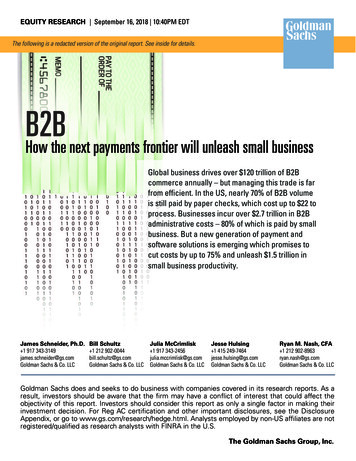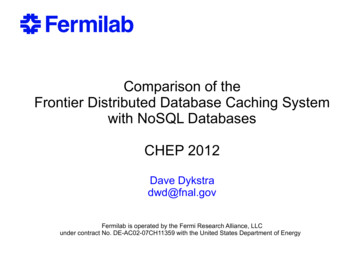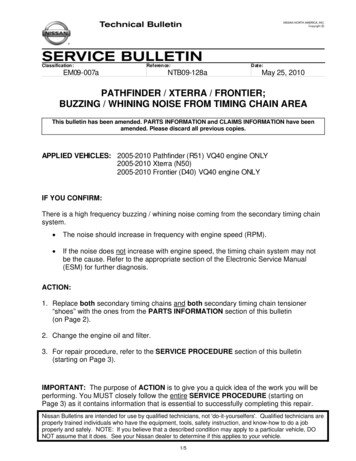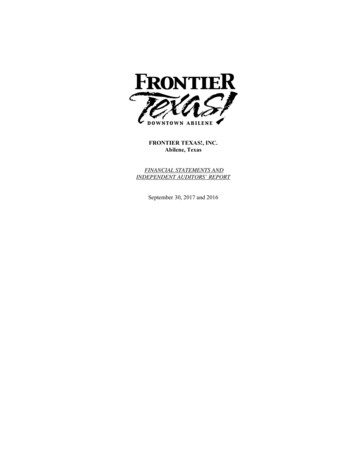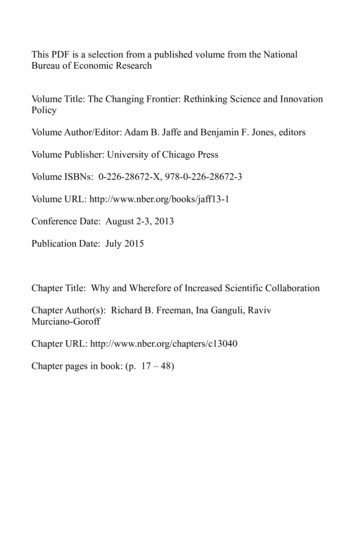
Transcription
This PDF is a selection from a published volume from the NationalBureau of Economic ResearchVolume Title: The Changing Frontier: Rethinking Science and InnovationPolicyVolume Author/Editor: Adam B. Jaffe and Benjamin F. Jones, editorsVolume Publisher: University of Chicago PressVolume ISBNs: 0-226-28672-X, 978-0-226-28672-3Volume URL: http://www.nber.org/books/jaff13-1Conference Date: August 2-3, 2013Publication Date: July 2015Chapter Title: Why and Wherefore of Increased Scientific CollaborationChapter Author(s): Richard B. Freeman, Ina Ganguli, RavivMurciano-GoroffChapter URL: http://www.nber.org/chapters/c13040Chapter pages in book: (p. 17 – 48)
1Why and Wherefore of IncreasedScientific CollaborationRichard B. Freeman, Ina Ganguli, andRaviv Murciano-GoroffScientists increasingly collaborate on research with other scientists, producing an upward trend in the numbers of authors on a paper (Jones, Wuchty,and Uzzi 2008; Wuchty, Jones, and Uzzi 2007; Adams et al. 2005). Paperswith larger numbers of authors garner more citations and are more likelyto be published in journals with high impact factors than papers with fewerauthors (Lawani 1986; Katz and Hicks 1997; deB. Beaver 2004; Wuchty,Jones, and Uzzi 2007; Freeman and Huang 2014), which seems to justifyincreased collaborations in terms of scientific productivity. The trend incoauthorship extends across country lines, with a larger proportion of paperscoauthored by scientists from different countries (National Science Board2012; Adams 2013). In the United States and other advanced economies, theproportion of papers with international coauthors increased from the 1990sthrough the first decade of the twenty- first century, while the proportion ofpapers with domestic coauthors stabilized. In emerging economies, wherecollaboration has not yet reached the proportions in the United States andRichard B. Freeman holds the Herbert Ascherman chair in economics at Harvard Universityand is a research associate of the National Bureau of Economic Research. Ina Ganguli is assistantprofessor at the University of Massachusetts Amherst, a research affiliate at the Stockholm Institute of Transition Economics (SITE) at the Stockholm School of Economics, and a postdoctoralaffiliate at the Center for International Development, Kennedy School of Government, HarvardUniversity. Raviv Murciano-Goroff is a PhD candidate in economics at Stanford University.We appreciate assistance with the survey from John Trumpbour and input from JenniferAmadeo-Holl, Paula Stephan, and Andrew Wang. We received helpful comments from AdamJaffe, Ben Jones, Manuel Trajtenberg, and participants at the NBER “The Changing Frontier:Rethinking Science and Innovation Policy” conferences. This research was supported in partby the National Science Foundation’s National Nanotechnology Initiative, award 0531146. Foracknowledgments, sources of research support, and disclosure of the authors’ material financial relationships, if any, please see http://www.nber.org/chapters/c13040.ack.17
18Richard B. Freeman, Ina Ganguli, and Raviv Murciano-Goroffother advanced countries, the share of papers with domestic collaborationsand the share with international collaborations have both increased.The spread of scientific workers and research and development activity around the world (Freeman 2010) has facilitated the increase in international collaborations. The growing number of science and engineeringPhDs in developing countries, some of whom are international studentsand postdocs returning to their country of origins (Scellato, Franzoni, andStephan 2012) has expanded the supply of potential collaborators outsidethe North American and Western European research centers. A rising trendin government and industry research and development (R&D) spending indeveloping countries and grant policies by the European Union and othercountries favor international cooperation. At the same time, the lower costof travel and communication has reduced the cost of collaborating withpersons across geographic locales (Agrawal and Goldfarb 2008; Catalini,Fons-Rosen, and Gaulé 2014). The increased presence of China in scientificresearch, exemplified by China’s move from a modest producer of scientificpapers to number two in scientific publications after the United States, hasbeen associated with huge increases in collaborations between Chinese scientists and those in other countries.1Finally, the location of scientific equipment and materials, such as theEuropean Organization for Nuclear Research (CERN)’s Large Hadron Collider, huge telescopes in particular areas, or geological or climatological dataavailable only in special localities, have also increased collaborations. TheUnited States was not a prime funder for CERN, but Americans are thelargest group of scientists and engineers working at CERN. China eschewedjoining the CERN initiative as an associate member state, but many Chinaborn scientists and engineers work at CERN as members of research teamsfrom other countries.How successful are collaborations across country lines and across locations in the same country? How do collaborators meet and develop successful research projects? What are the main advantages and challenges incollaborative research?To answer these questions, we combine data from a 2012 survey that weconducted of corresponding authors on collaborations with at least oneUS coauthor with bibliometric data from Web of Science (WoS) (ThomsonReuters 2012) in three growing fields—particle and field physics, nanoscience and nanotechnology, and biotechnology and applied microbiology.The survey data allow us to investigate the connections among coauthorsin collaborations and the views of corresponding authors about collaborations. The WoS data allows us to examine patterns of collaborations over1. Science and Engineering Indicators 2013, appendix table 5–27, gives scientific papers forthe top five countries in 2009: United States, 208,601; China, 74,019; Japan, 49,627; UnitedKingdom, 45,649; and Germany, 45,002.
Why and Wherefore of Increased Scientific Collaboration19time and to compare patterns found in our fields to those found in scientificpublications broadly. To determine whether borders or space are the primaryfactors that affects the nature and impact of collaborations, we contrast collaborations across locations in the United States, collaborations in the samecity in the United States, and collaborations with international researchers.We find that US collaborations increased across US cities as well as internationally and that scientists involved in these collaborations and those whocollaborate in the same locale report broad similarities in their experiences.Most collaborators first met while working in the same institution. Most saythat face-to- face meetings are important in communicating with coauthorsacross distances. And most say that specialized knowledge and skills of coauthors drive their collaborations. We find that international collaborationshave a statistically significant higher citation rate than domestic collaborations only in biotech, a modestly higher citation rate in particle physics,but a lower rate in nanotech. Because international collaborations have agreater number of authors than other collaborations, once we account forthe number of coauthors on papers, the higher citation rate for biotechand particle physics international collaborations also disappear. Our resultssuggest that the benefits to international collaboration in terms of citationsdepend on the scientific field in question, rather than from any “internationalmagic” operating on collaborations with the same number of researchers. Bylimiting our sample to papers with at least one US- based author, however,we exclude the possibility that international collaborations greatly benefitresearchers in countries with smaller research communities by linking themto experts outside their country, the United States aside.1.1 The Growing Trend of International CollaborationWe analyze data from corresponding authors and articles in whichresearchers collaborate in particle and field physics, nanoscience and nanotechnology, and biotechnology and applied microbiology. These three fieldscover a wide span of scientific activity, with different research tools andmethodologies.Particle physics has a theoretical part and an empirical part. Leading edgeempirical research requires massive investments in accelerators and colliders, of which the Large Hadron Collider is the most striking. Europe’s decision to fund the Hadron Collider while the United States’ rejection to builda large collider in Texas shifted the geographic locus of empirical researchfrom the United States to Europe and arguably spurred the greater growthof string theory (which does not need direct access to the Collider) in theUnited States than in Europe. Particle physics is the most mathematicallyand theoretically sophisticated of the sciences we study, where pathbreakingmathematical analysis guides empirical work, and where the massive equipment exemplifies big science.
20Richard B. Freeman, Ina Ganguli, and Raviv Murciano-GoroffNanotechnology is a general interdisciplinary applied technology, whereengineers often collaborate with material scientists. The electron microscopeis a pivotal research tool. The United States made sizable investments innanotechnology beginning at the turn of the twenty- first century, whenPresident Clinton called for greater investment in nano- related science andtechnology. This led to the 21st Century Nanotechnology Research and Development Act that President Bush signed in 2003. Other countries undertook similar initiatives in the same period.Biotechnology is lab- based, in which the National Institutes of Health(NIH) dominates basic research funding, but where big pharmaceuticalfirms also fund considerable research. The most important change in biotechresearch technology has been the US- sponsored Human Genome Projectand associated new methods of genetic analysis and engineering that allowlabs around the world to modify the biological underpinnings of living creatures to advance medicine and improve biological products and processes.To measure collaboration patterns in the three fields, we use publicationdata from the WoS. We identified all papers in the WoS database from 1990–2010, with at least one US coauthor in journal subject categories particleand field physics; nanoscience and nanotechnology; and biotechnology andapplied microbiology. From these papers, we identify teams by the names ofcoauthors and locate the authors by author affiliations. This sample includes125,808 papers.Using the location of the authors on each paper, we define four types ofcollaborations:US- only collaborations, divided into US colocated, in which all USauthors are in the same city; US non- colocated, in which US coauthorsare in at least two different cities; international collaborations, divided intointernational/US colocated, in which US coauthors are in the same city withat least one foreign coauthor; and international/US non- colocated, in whichUS coauthors are in two or more cities with at least one foreign coauthor.Distinguishing between these forms of collaborations allows us to identify differences between papers with international collaborations and paperswith collaborations in different locations, whether they are in the UnitedStates or overseas, as well as between papers with collaborations across locations within the United States. By focusing only on papers in which thereis some US presence, our analysis may not generalize to papers written inwhich all authors are based outside the United States; by differentiating citylocation only for US coauthors, our findings do not address the potentialeffects of colocation or non- colocation of non-US- based researchers onpaper outcomes.Figure 1.1 displays the proportion of papers in our four categories and theproportion with single authors in the three fields taken together in each year.The solid top line gives the share of papers in which a US- based author collaborates solely with authors colocated in the same city. It shows a marked
Why and Wherefore of Increased Scientific Collaboration21Fig. 1.1 Share of papers by collaboration typeNotes: Includes all papers in the Web of Science database with at least one US author, andwith journal subject categories of particle and field physics, nanoscience and nanotechnology,and biotechnology and applied microbiology, published from 1990 to 2010.decrease in collaborations between these authors from 1990 through 2000,which then stabilizes at about 40 percent of papers. The line labeled Soloshows the proportion of papers that are solo authored. It drops from 20 percent to about 5 percent from 1990 to 2010. The line for International/USColocated papers gives the share of papers for which at least one of theauthors is in another country while all US authors are in the same city. Itincreases by 18 percentage points from 1990 to 2010. The line for International/US non- colocated increases by about 5 percentage points from 1990to 2010. Most of the increase in international collaborations was betweenUS scientists based in one location and persons in another country. Overall,while papers with authors in different US cities increased less than international collaborations, the data shows that increased geographic scope ofcollaborations involved more than crossing national boundaries.To see whether the trend in collaborations varied noticeably among fields,figures 1.2A, 1.2B, and 1.2C display the proportion of papers by collaboration type for the three fields separately. The data for particle physics in figure1.2A show the highest level of international collaborations, due presumablyto the importance of particle accelerators and other equipment that are available at only some sites. Figures 1.2B and 1.2C show that in nano and biotech,the most common form
the North American and Western European research centers. A rising trend in government and industry research and development (R&D) spending in developing countries and grant policies by the European Union and other countries favor international cooperation. At the same time, the lower cost of travel and communication has reduced the cost of collaborating with persons across geographic locales .





